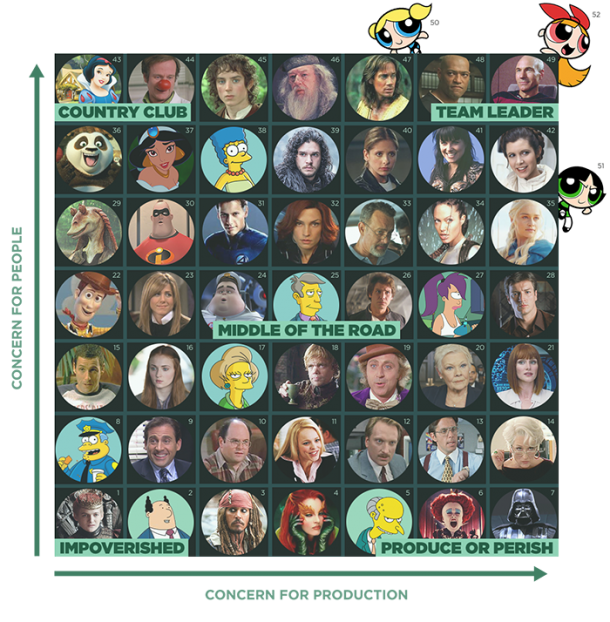From Snow White to Darth Vader: Identify Your Leadership Style Using the Managerial Grid

The Blake Mouton Managerial Grid (also known as the leadership grid) is a classic model used by managers to assess their leadership style. Proposed by two management theorists, Robert R. Blake and Jane Mouton, in their book The Managerial Grid: The Key to Leadership Excellence (1964), the model maps a leader’s behaviour by plotting coordinates along two axes:
- Concern for Production (X axis):
- Concern for People (Y axis):
This results in five main types of leadership styles:

- Impoverished: Low concern for workers’ needs and low concern for organisational results; a laissez-faire or avoidance style. The leader tries to protect him or herself from getting involved in mistakes. May lead to employees learning to solve problems on their own over the short term; however, this style generally leads to chaos over the long term.
- Country club: High concern for workers’ needs but low concern for results; an accommodating or yielding style. The leader tries to be friendly, empathetic, and provide emotional support without emphasising deadlines or job demands. May lead to employee satisfaction but not full engagement. Laziness and letting the quality of the work slide is a danger.
- Middle-of-the-road: Moderate concern for workers’ needs and company results; a balancing or compromising style. People may feel that a certain amount of personal care or professional attention to the task is missing, leaving needs unmet. Leads to average performance.
- Produce or perish: (Based on McGregor’s Theory X) High concern for results but low concern for workers’ needs; an autocratic or dictatorial style. The leader maximises output over the short run, though it generally leads to high staff turnover over the long run. This approach is rooted in fear and punishment.
- Team leader: (Based on McGregor’s Theory Y) High concern for workers’ needs and high concern for results; a transformational or empowering style. Leads to high performance. This approach is rooted in mutual trust and accountability.
Since first introduced in 1964, the Managerial Grid has gone through a series of updates by the authors, including changes to the names of the five leadership styles; however, the classic model (shown above) is still the most popular version in circulation.
Those familiar with the famed Situational Leadership model by Ken Blanchard and Paul Hersey — a 4-quadrant model that assigns leadership styles according to directive behaviour (X axis) and supportive behaviour (Y axis) — will notice a striking similarity. Much like the two authors of the Situational Leadership model, the two authors behind the Managerial Grid do not advocate a one-style-fits-all approach to leadership. To be effective, the authors agree that a leader must adjust their style to fit the demands of the environment.
Even though one style is not sensible in all situations at all times, the space between Middle-of-the-Road (5,5) and Team Leader (9,9) is considered to be the most desirable baseline, home, or "green zone," with the Team Leader style considered to be the best style overall.
The Managerial Grid is a great reminder that the two core elements of leadership — people and results — are not mutually exclusive. You don't have to be an asshole in order to get things done. Likewise, you don't have to be a pushover in order to be liked. The emotionally mature leader shoots high and leans right.
TV / Movie Character Version
For a bit of fun, we decided to re-imagine the Managerial Grid by adding famous TV/Movie characters to make it easier for people relate to each zone. We've tried to select only characters who hold — or who have, at some time, held — either formal or informal positions of leadership within their respective fictional worlds. (Warning: some selections are super geeky.)

As your eyes wonder the grid, you might like to reflect on a few questions:
- Which character types have you worked for in the past?
- Which character types do you identify with?
- Are there character selections you disagree with? Why?
- Which characters would you add?
- Where would you place your colleagues?
- Where would your colleagues place you?
Whichever version of the managerial grid you may decide to use in your organisational training, it provides a simple yet powerful model for HR and L&D teams. The model can kick off a leadership training event or executive coaching program, giving managers a good starting point to identify their primary leadership style. This serves as a foundation for creating professional development plans that ultimately shape managers into transformational leaders who drive business results while keeping talent happy, engaged, and retained.
Grid number reference:
- Joffrey Baratheon, Game of Thrones
- Pointy-haired Boss, Dilbert
- Captain Jack Sparrow, Pirates of the Caribbean
- Poison Ivy, Batman & Robin
- Mr Burns, The Simpsons
- The Red Queen, Alice in Wonderland
- Darth Vader, Star Wars
- Chief Wiggum, The Simpsons
- Michael Scott, The Office
- George Costanza, Seinfeld
- Regina George, Mean Girls
- Ed Rooney, Ferris Bueller's Day Off
- Bill Lumbergh, Office Space
- Miranda Priestly, The Devil Wears Prada
- Longfellow Deeds, Mr Deeds
- Sansa Stark, Game of Thrones
- Edna Krabappel, The Simpsons
- Tyrion Lannister, Game of Thrones
- Willy Wonka, Charlie and the Chocolate Factory
- M, Casino Royale
- Claire Dearing, Jurassic World
- Woody, Toy Story
- Rachel Green, Friends
- Captain B. McCrea, WALL-E
- Principal Skinner, The Simpsons
- Han Solo, Star Wars
- Captain Turanga Leela, Futurama
- Captain Malcolm Reynolds, Firefly/Serenity
- Jar Jar Binks, Star Wars
- Mr Incredible, The Incredibles
- Mr Fantastic, The Fantastic 4
- Jean Grey, X-Men
- Captain Richard Phillips, Captain Phillips
- Lara Croft, Tomb Raider
- Khaleesi, Game of Thrones
- Po, Kung Fu Panda
- Princess Jasmine, Aladdin
- Marge Simpson, The Simpson
- Jon Snow, Game of Thrones
- Buffy Summers, Buffy the Vampire Slayer
- Xena, Xena: Warrior Princess
- Princess Leia, Star Wars
- Princess Snow White, Snow White and the Seven Dwarfs
- Patch Adams, Patch Adams
- Frodo Baggins, Lord of the Rings
- Professor Albus Dumbledore, Harry Potter
- Hercules, Hercules: The Legendary Journeys
- Morpheus, The Matrix
- Captain Jean-Luc Picard, Star Trek
- Bubbles, The Powerpuff Girls
- Buttercup, The Powerpuff Girls
- Blossom, The Powerpuff Girls
Topics:
Leadership
Theo Winter
Client Services Manager, Writer & Researcher. Theo is one of the youngest professionals in the world to earn an accreditation in TTI Success Insight's suite of psychometric assessments. For more than a decade, he worked with hundreds of HR, L&D and OD professionals and consultants to improve engagement, performance and emotional intelligence of leaders and their teams. He authored the book "40 Must-Know Business Models for People Leaders."

/3%20Things%20Managers%20Should%20Know%20About%20Leadership.png?width=374&name=3%20Things%20Managers%20Should%20Know%20About%20Leadership.png)

We Would Like to Hear From You (0 Comments)